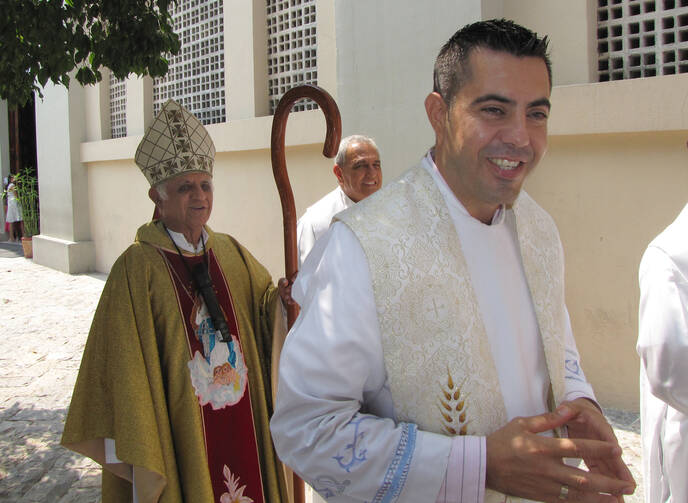A Courageous Bishop
The Mexican gang that calls itself the Knights Templar, known by its ceremonial white robes with red crosses, enforces a strict code of moral conduct on its members and vows to protect the oppressed, the widow and the orphan. They also have a corner on the methamphetamine market in the western state of Michoacán. Taking their name from the medieval Christian order of crusaders, this quasi-religious drug cartel has cowed or bought off local officials and police and extorts heavy fines from business owners and farmers in the region. Civilians in at least six towns, unconvinced that leaders in Mexico City have the will or the way to take on the drug lords, have formed armed self-defense groups to throw off the reign of terror.
One Catholic bishop, Miguel Patiño Velazquez, 75, of Apatzingán, spoke in remarkably blunt terms about his support for the militias in their struggle against the cartel, which he called out by name at great personal risk. “Kidnappings, abductions, murders and bribes have increased, to the point that entire families have been forced to emigrate,” he wrote in a pastoral letter issued on Oct. 16. He said Michoacán is becoming a “failed state” and called on the government to restore the rule of law.
Over 60,000 lives have been lost across Mexico since former president Felipe Calderón escalated the quite literal war on drugs, deploying thousands of troops to root out drug lords and corrupt police forces, a militarization of the conflict that his successor has reluctantly continued. During his trip to Latin America in July, Pope Francis said the scourge of drug trafficking “requires an act of courage from society as a whole.” We hope many more in Mexico and the United States will be inspired to act by the example of one very brave bishop.
Bring Them Home
Since the end of the 18th century, Afghanistan has chewed up its invaders and spit them out. Each of them imagined that despite its geography and harsh terrain, Afghanistan could be overcome by force. The United States arrived in October 2001 to punish Osama bin Laden and the Taliban. Since then about 2,290 American soldiers have died, more than 1,500 have lost arms or legs and a third suffer traumatic stress related to combat.
Although the Obama administration had promised a total withdrawal in 2014, it is currently negotiating to extend the presence of 12,000 troops for another 10 years. President Hamid Karzai of Afghanistan, angered by an air strike that killed a child and injured two women, insists that U.S. and NATO forces cease all drone strikes and raids on Afghan homes and allow U.S. soldiers to be tried in Afghan courts.
The recent rise in the killing of aid workers (36 as of November) might suggest that U.S. troops should remain in order to enforce civil stability, but nation building is not the responsibility of the military. As Afghanistan prepares for a presidential election in April, the Karzai family, which has a reputation for corruption, has announced Hamid’s brother Qajum will be his successor.
The protest against drone killings and other military atrocities is justified and is an additional reason for the United States to withdraw. Once again, Afghanistan has worn down its would-be conquerors. It is time for Afghanistan to confront its own internal problems, and for U.S. forces to leave.
Pension Pinching
Detroit’s public sector workers had counted on city pensions as the foundation of a dignified and decent retirement. But on Dec. 3 a federal bankruptcy court cast those expectations aside, green-lighting the city’s Chapter 9 filing.
What happens in Detroit will not stay in Detroit. Scores of other municipalities teeter on a fiscal brink. City managers may now perceive municipal bankruptcy, previously a civic anathema, as a plausible recourse to escape long-term pension and health care obligations that were publicly negotiated, then negligently funded. But seizing on municipal bankruptcy as an easy out—or using the threat of bankruptcy to extort punitive concessions from embattled public sector workers—cannot become a new exemplar of “fiscal realism.”
Detroit’s demise has many authors. Like the tortured obituaries that can be written for other struggling cities, its tale would not be complete without understanding the role and responsibilities of multiple forces, including the epic implosion of Wall Street-facilitated financing schemes. Yet in the public imagination, it is the weight of pension obligations that seems to pull down U.S. cities.
Detroit’s 21,000 retired workers had been anticipating modest retirement incomes of $19,000 to $30,000 annually. They now face pension reductions that will ruin them. Michigan politicians have taken the position that this outcome, though regrettable, is an inevitable outcome of the fiscal forces at work in Detroit. Not so. A state that can locate $283 million to subsidize a billionaire’s new hockey arena can scrape together the resources necessary to honor the promises it made to its own citizens.









Mr. Dunn,
Thanks for your comments. There is some dispute as to how much $ is actually needed to set the retirement and health funds to right. The Detroit Firefighters union and other analysts say that Orr is exaggerating weight of long-term burdens for political effect. You note that fixing the gap outside of bankruptcy would require billions, but those billions would not have to be raised in a single fiscal year, as you suggest above. In fact, switching out, for example, the $240 million in public money for the hockey stadium to general op would put the city in the black for more than a year. And yes, we don't find a tax increase meant to salvage pensions anathema.
You may find these alternative takes on the nature of the crisis (i.e., cash flow, not long-term debt) and the potential for a more humane resolution to it of interest here and here.
Cheers,
Kevin